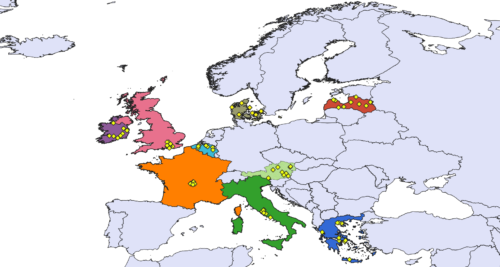INSIGNIA study Year 2
First results analysis of Year 1, allowed a decision taken by the whole consortium about the best matrixes to be ring tested during Year 2 in 9 European countries and 9 apiaries per country. Therefore for Year 2, two (2) colonies will be used per apiary, and apistrips together with pollen from pollen traps will be sampled biweekly, from April to September 2020. The countries participating in Year 2 are: Austria, Belgium, Denmark, France, Greece, Ireland, Italy, Latvia and UK.
The map of the locatons were the participating apiaries are is right here!

Invitations for CSs
In order to receive participants, whiling to act as Citizen Scientists in our project, National Coordinators (NatCos) were assigned in each one of 9 partner countries and they used different methodology to recruit the participants for Year 2. For example:
In Austria, citizen scientists were invited to participate in the study by publishing an article about INSIGNIA and its project goals in “Bienenaktuell”, the largest beekeeping journal of Austria and interested parties were asked to write a short introduction of their persons (beekeeping experience) and the environment they keep bees in and to send by email to the national coordinators to proof their digital literacy.
In Belgium, a Newsletter was sent by Honeybee Valley to the Belgian beekeepers with a short description of the project and a call to participate. Candidate beekeepers were asked to fill in a short survey to become a potential Citizen Scientist.
In Denmark, a presentation about the INSIGNIA project was made in on one of the workshops related to another project on ‘improving pollen and propolis collection’, where participating beekeepers were already trained.
In France, a presentation about the INSIGNIA project was done to amateurs and professonal beekeepers (CANEC scientific comittee and the CANEC general assembly), and there was a call for volunteer CANEC beekeepers.
In Creece, beekeepers were informed about the INSIGNIA project through different media, such as FB page and Web page of the Project, but also through a detailed article written in the beekeeping journal published every two months by the Federation of Greek Beekeepers’ Associations, “Melissokomiko Vima”.
In Italy, a list of potential citizen science beekeepers has been written by Italian NatCos, depending on previous experience and later in a meeting with the presidents of the regional beekeeping associations local beekeepers interested to participate were found.
In Ireland, beekeepers who actively participated in the CSI pollen project were contacted personally and given first option to be actively involved. Then after contact with the secretaries of different local beekeepers’ associations a list of names and contact details of r beekeepers was created.
In UK, 75 beekeepers which had been recruited in England and Wales to take part in the CSI Pollen project between 2014-2016, were approached. In addition, an article about the new INSIGNIA project was published in the UK national journal Bee Craft, and several talks were given to appropriate beekeepers associations describing the project.
It has become clear though, that in all countries, the response from the beekeepers was very high and a kind of a selection had to be done, which was mainly based on the fact that we would prefer: a) to have experienced beekeepers and not beginners; b) the sites and colony locations should be representative of the land and also represent both high and low risk areas (meaning risk for pesticides); c) that the locations should not be in a very remore area, which would make the transfer of samples in cool chain difficult.
All set then! Lets show what is going out there in terms of pesticdes!
Written by Fani Hatjina
National Coordinator for Greece
